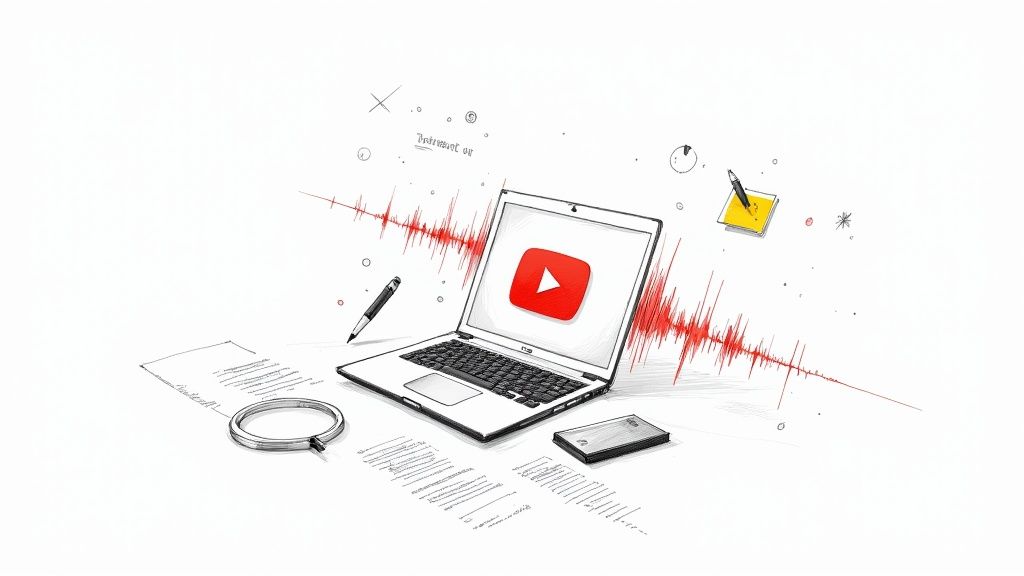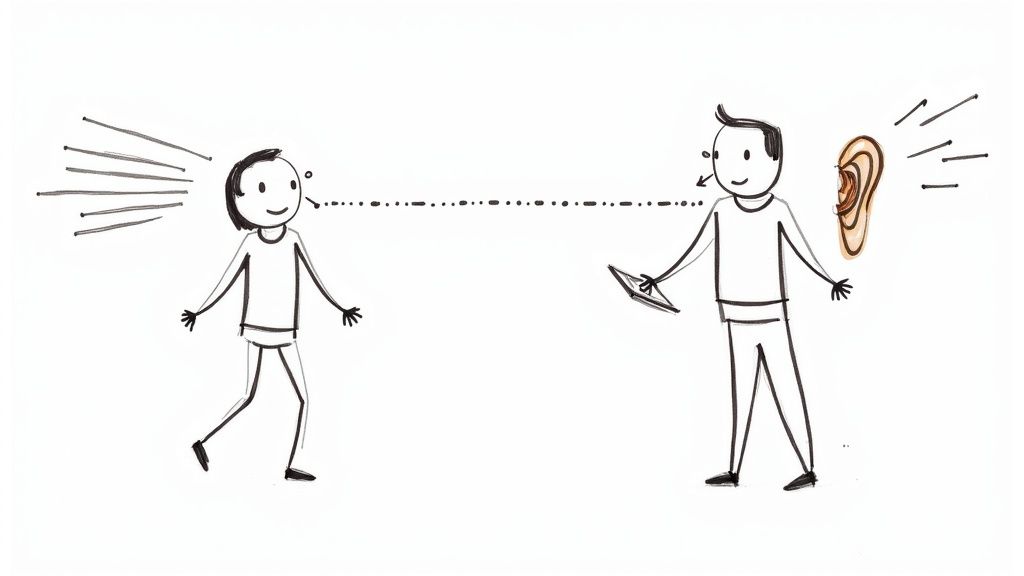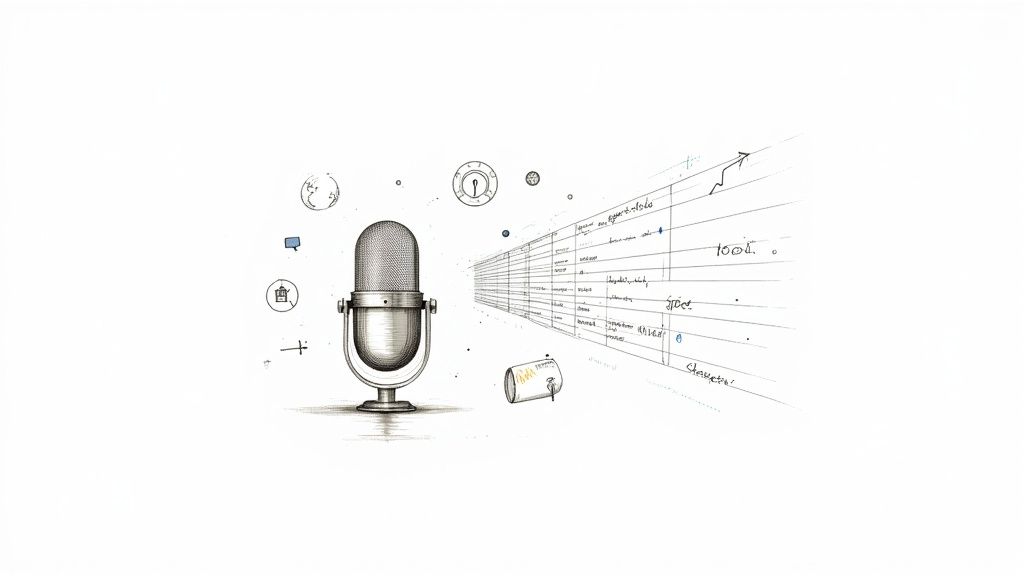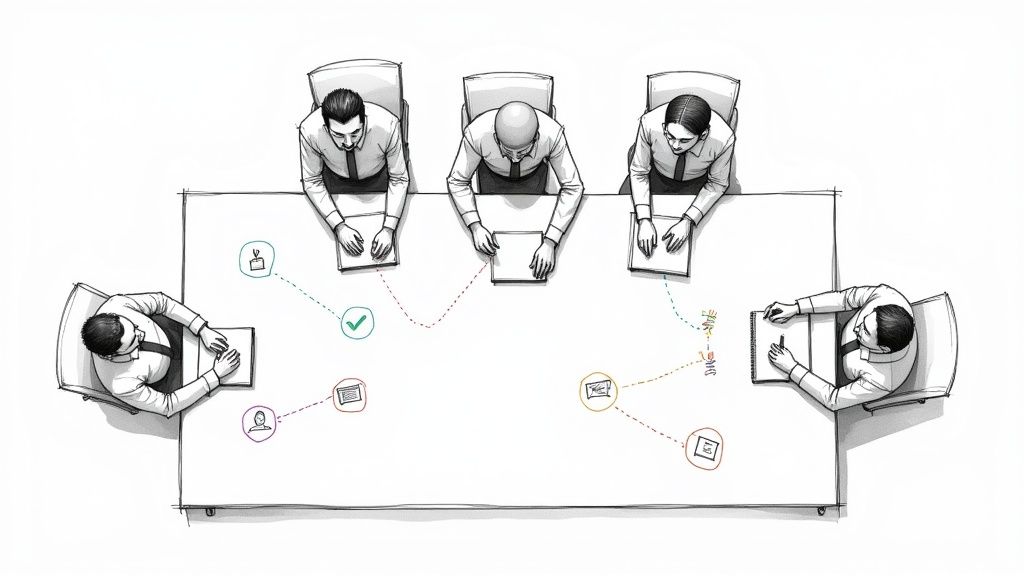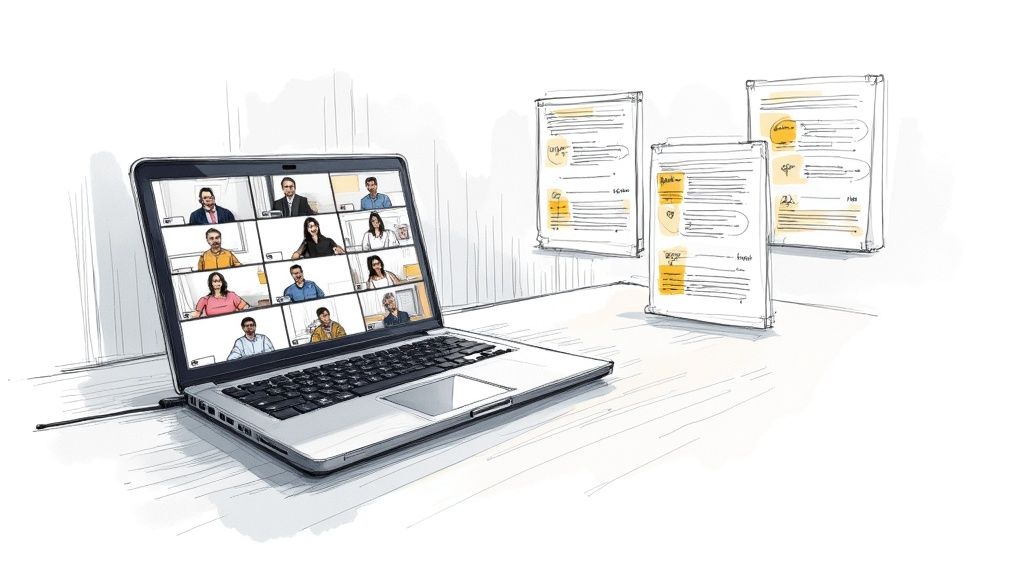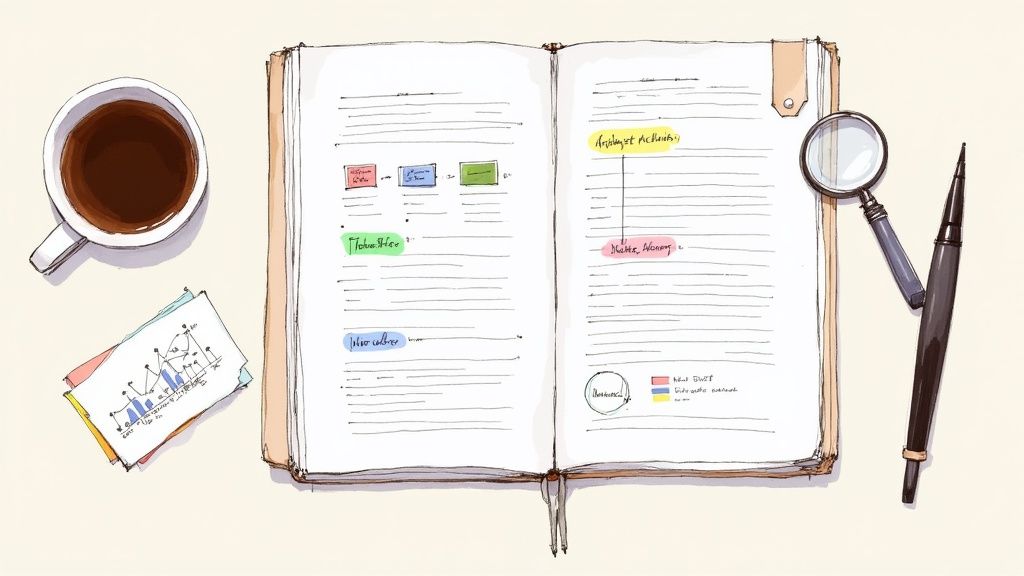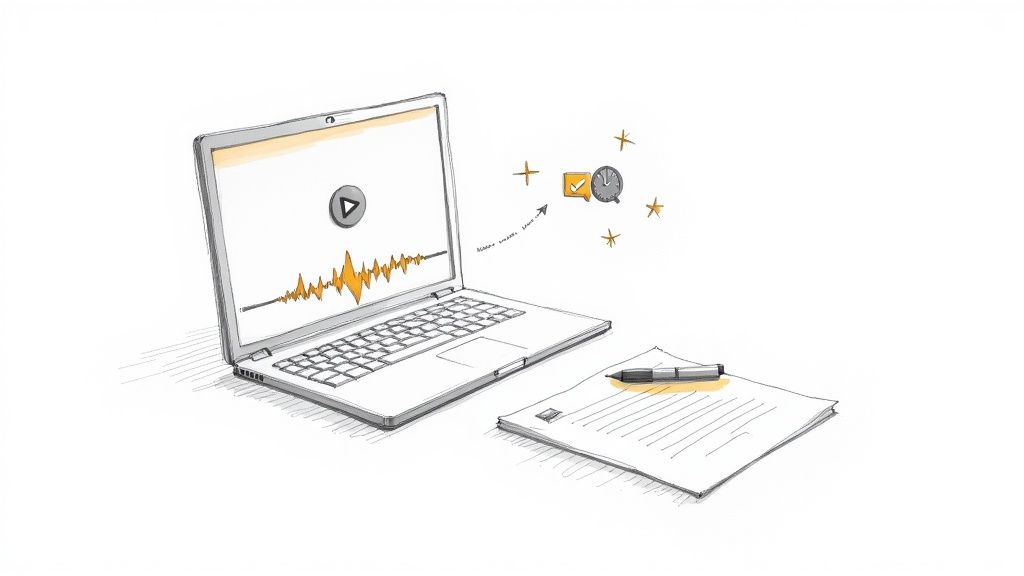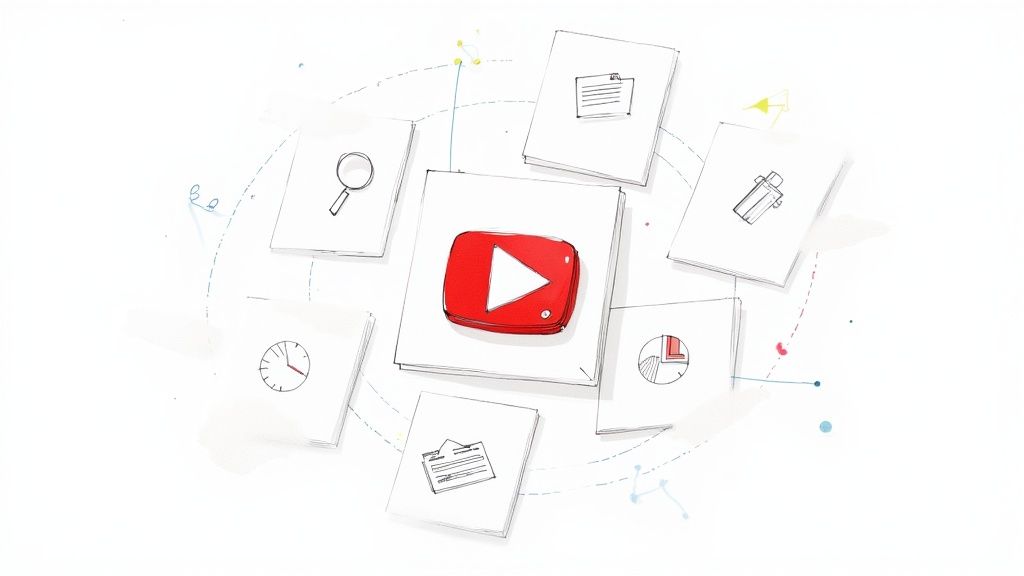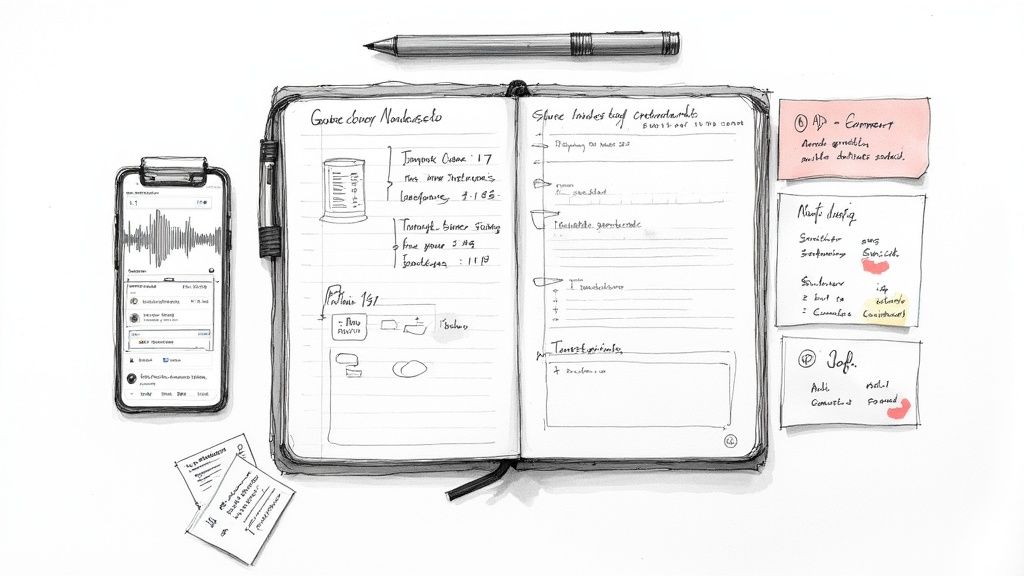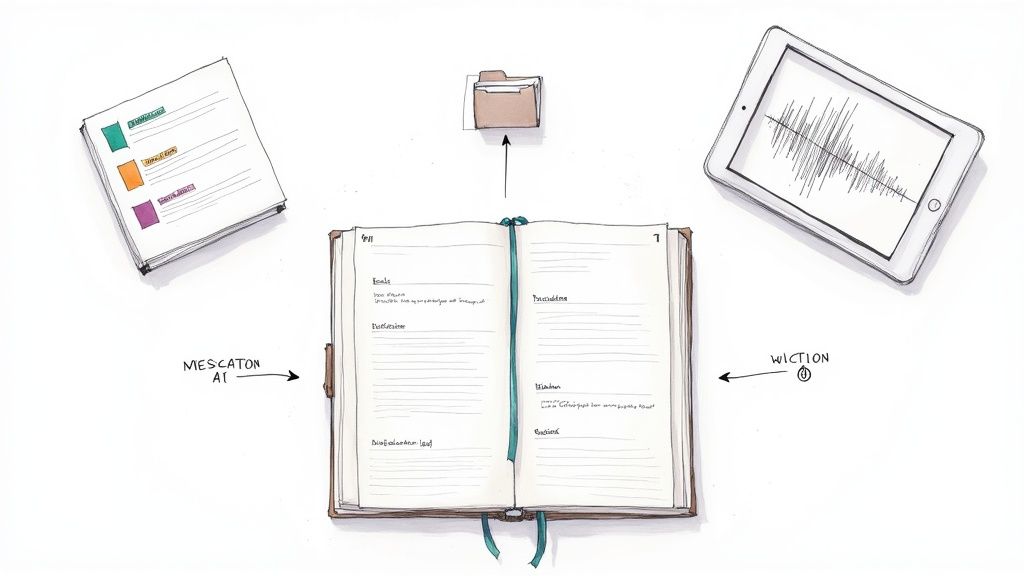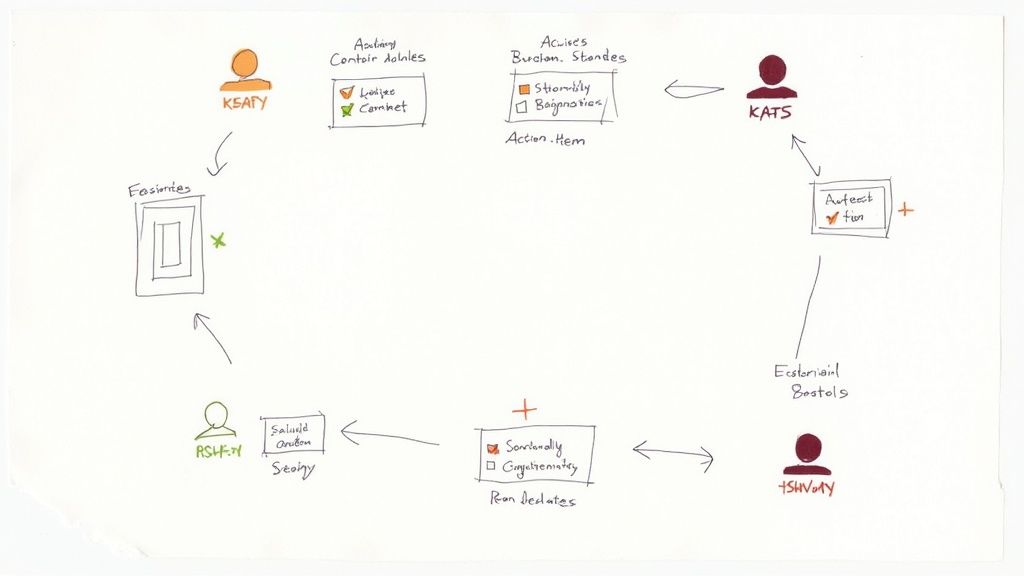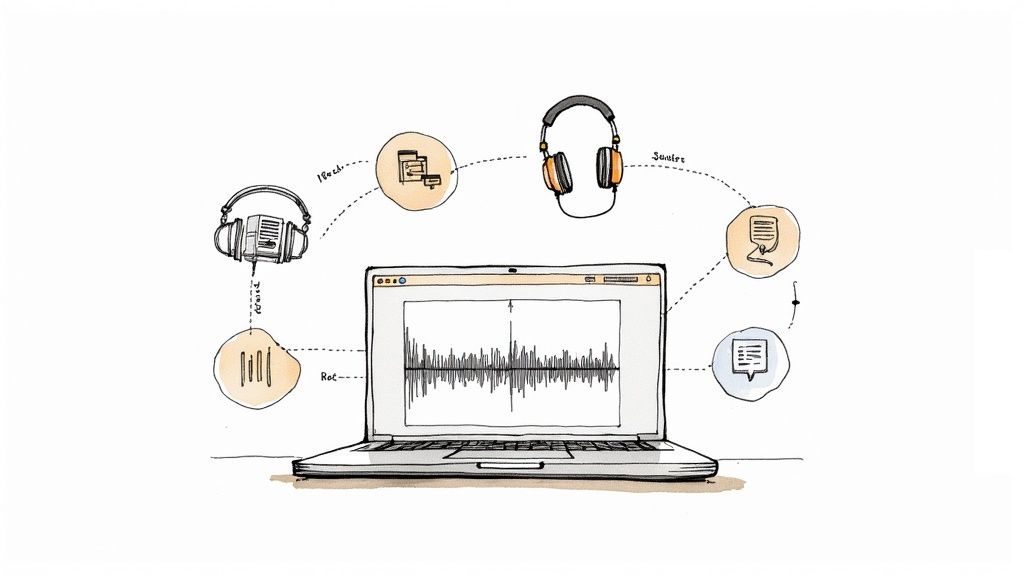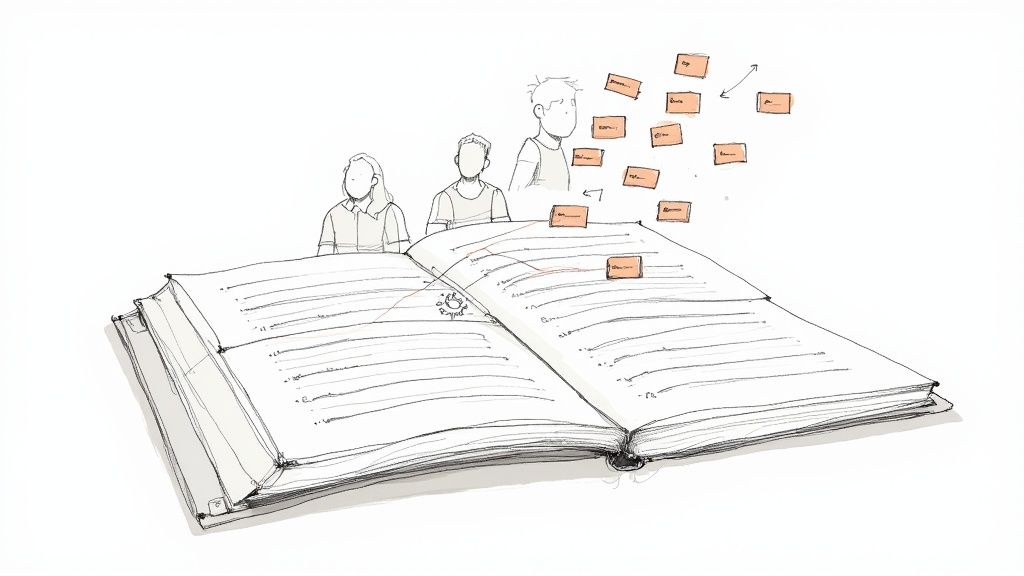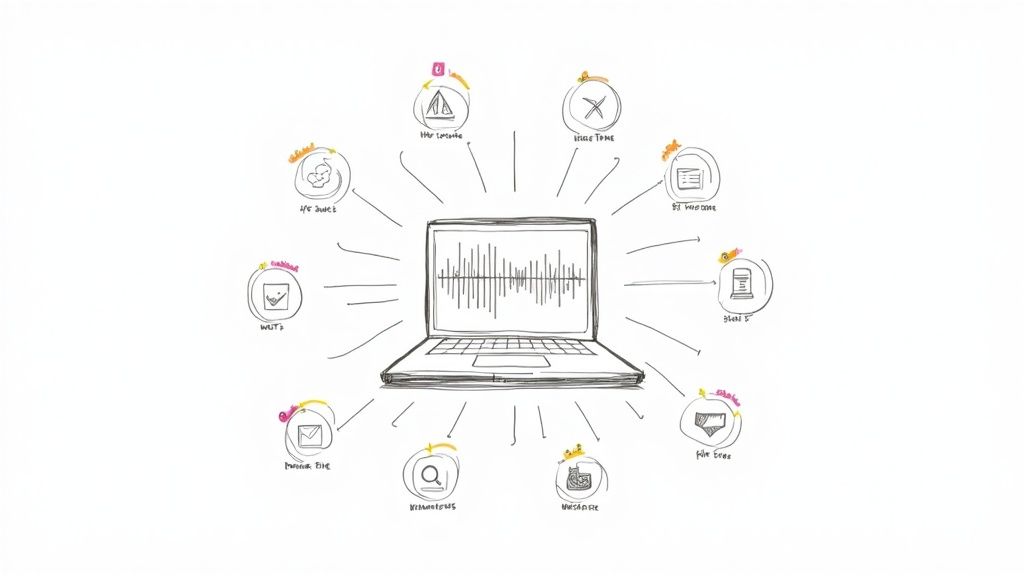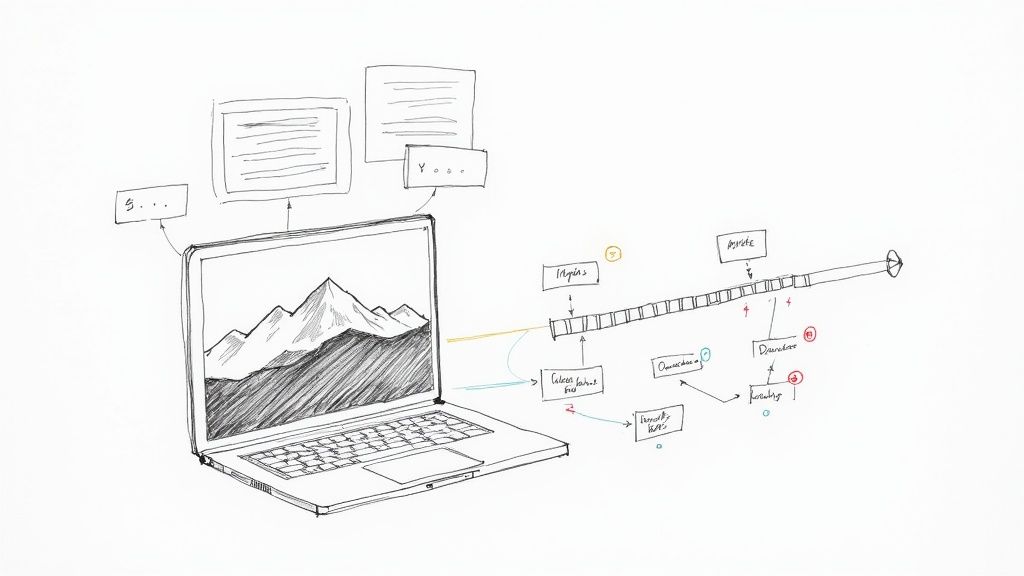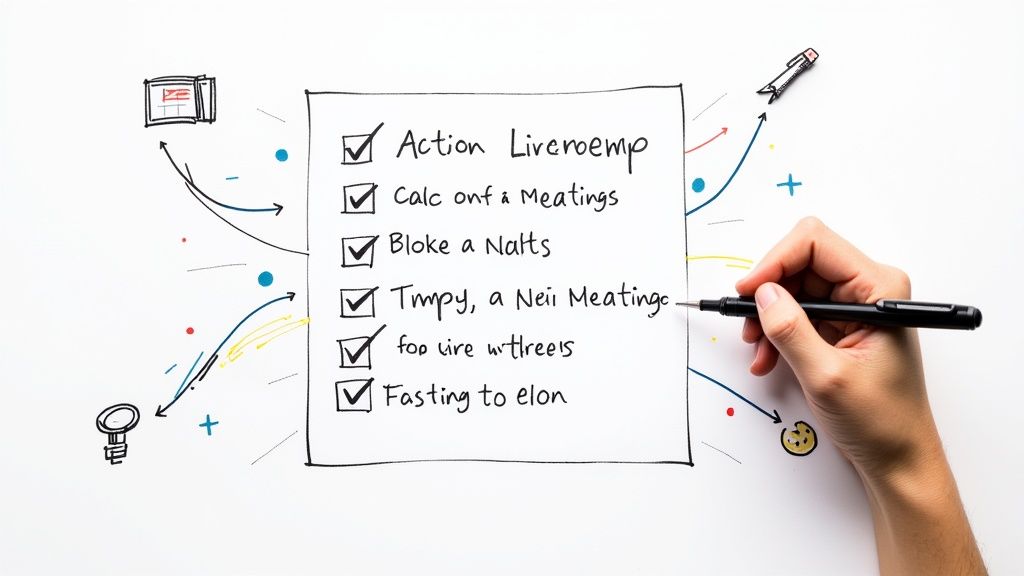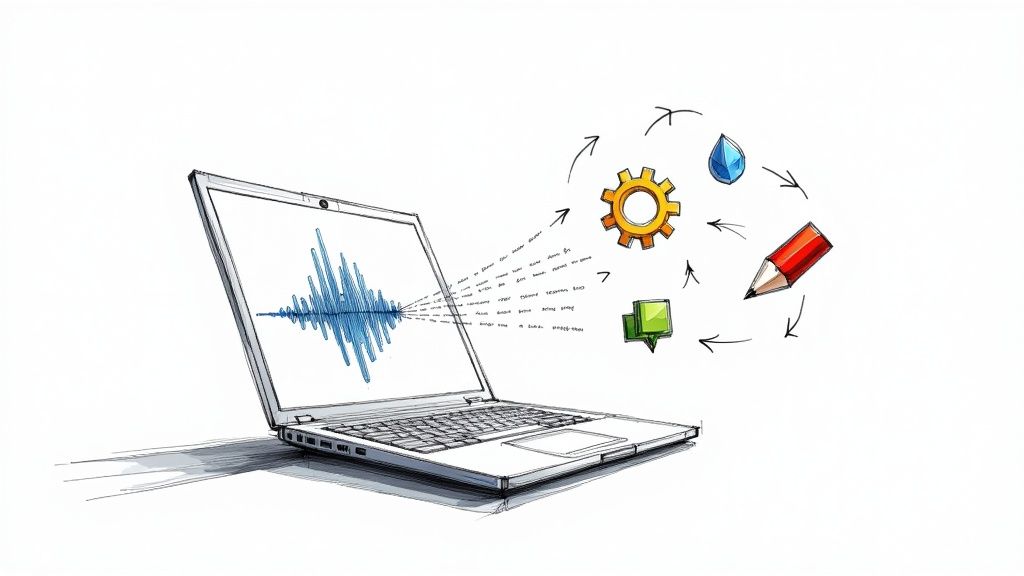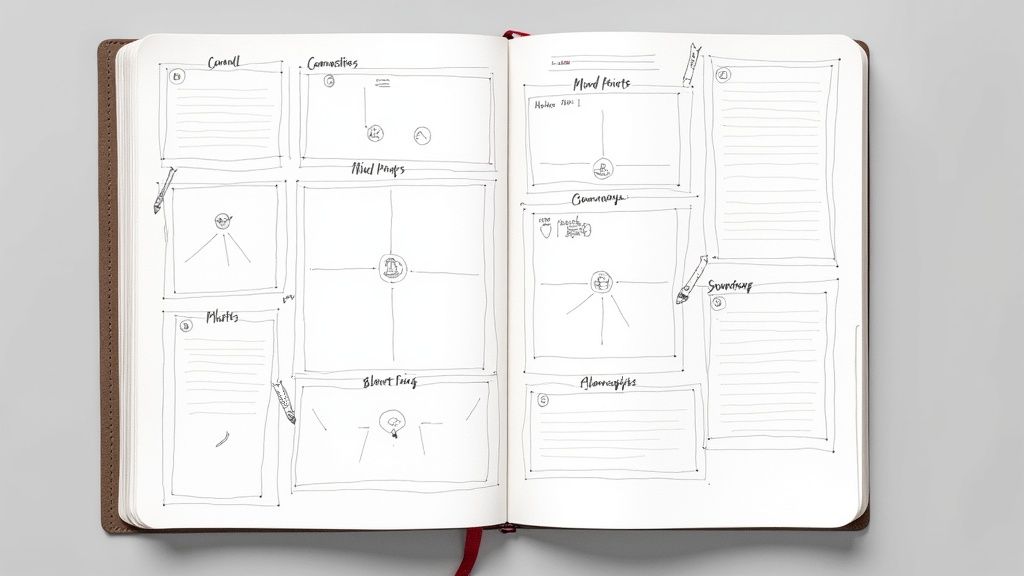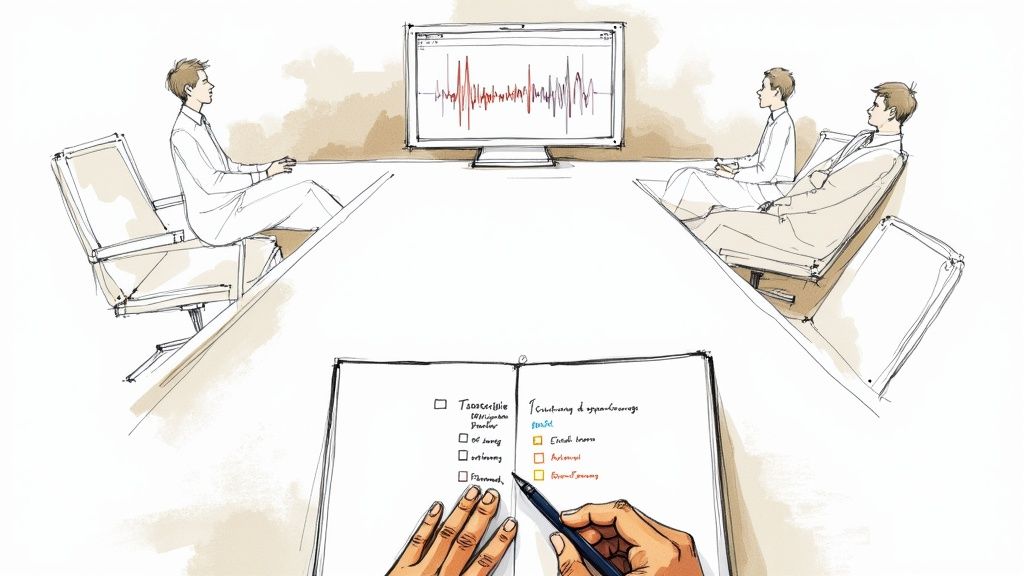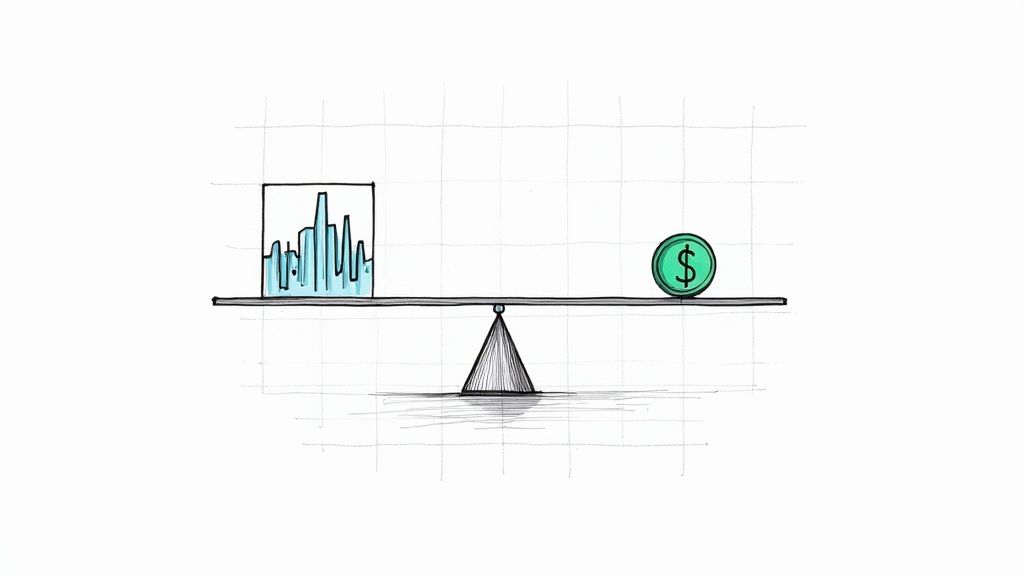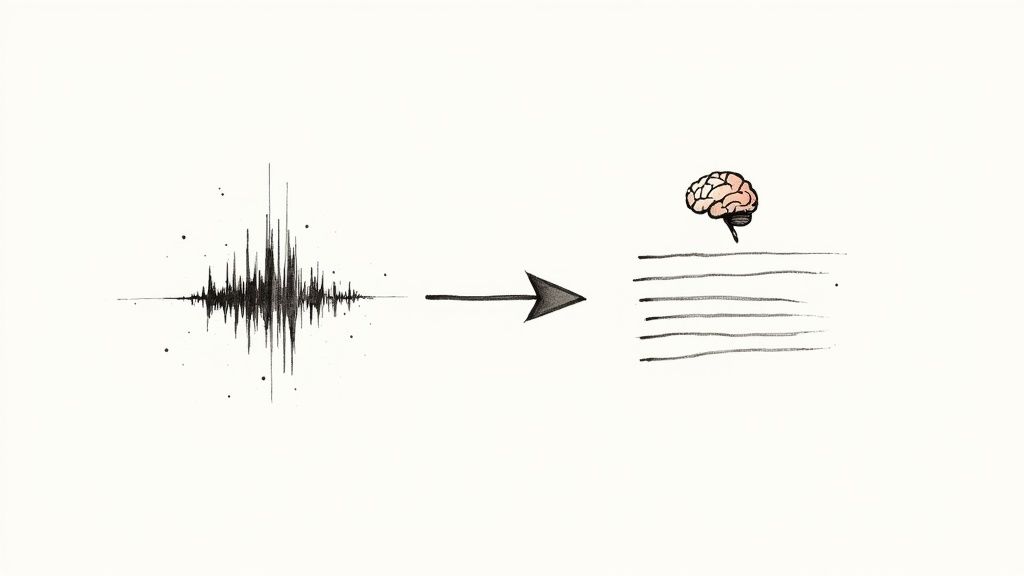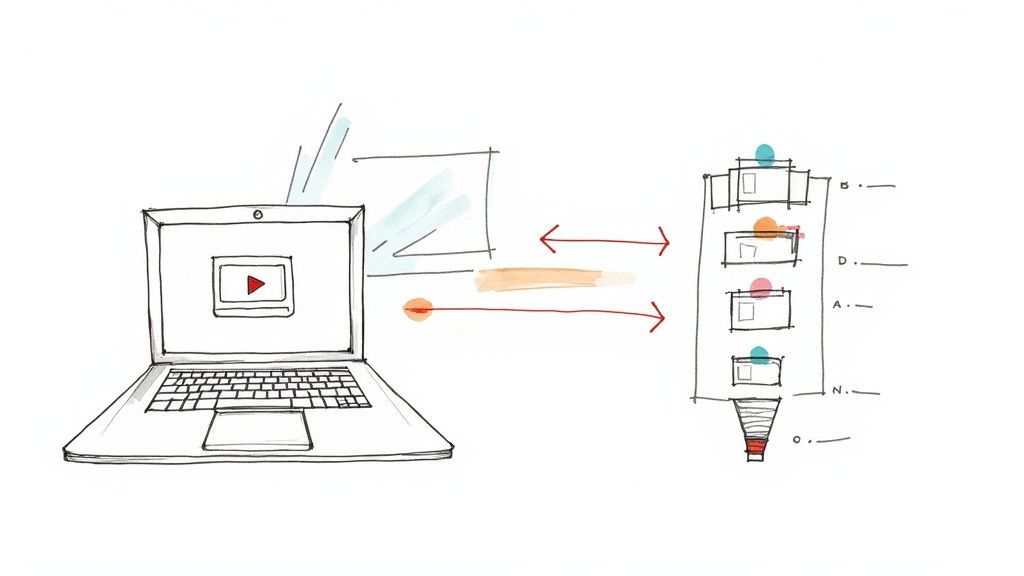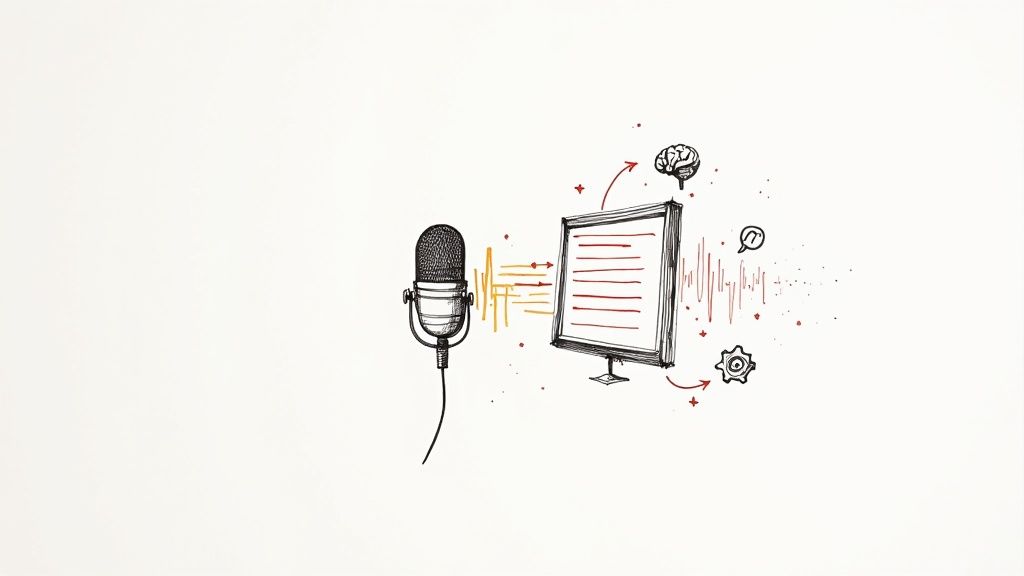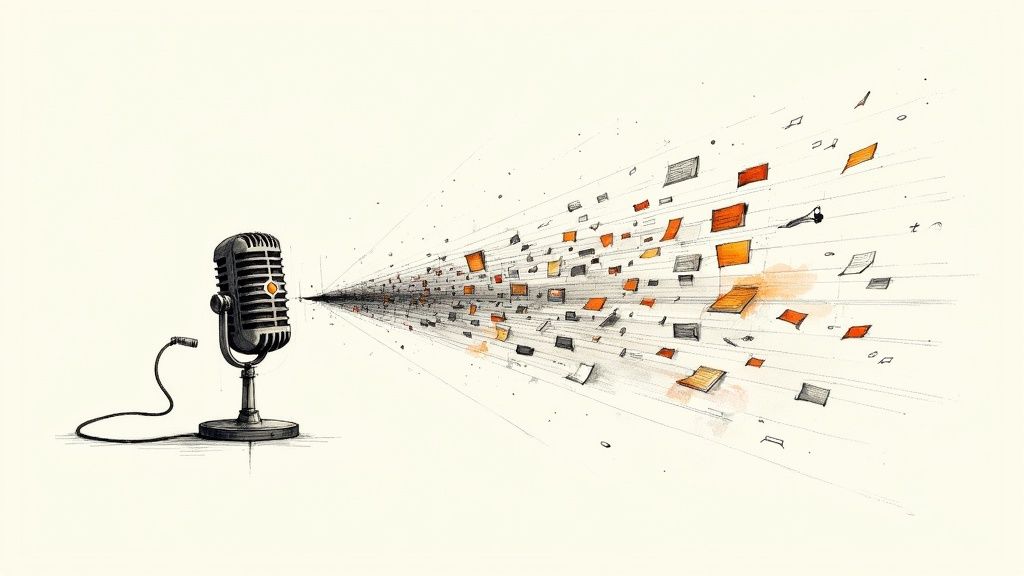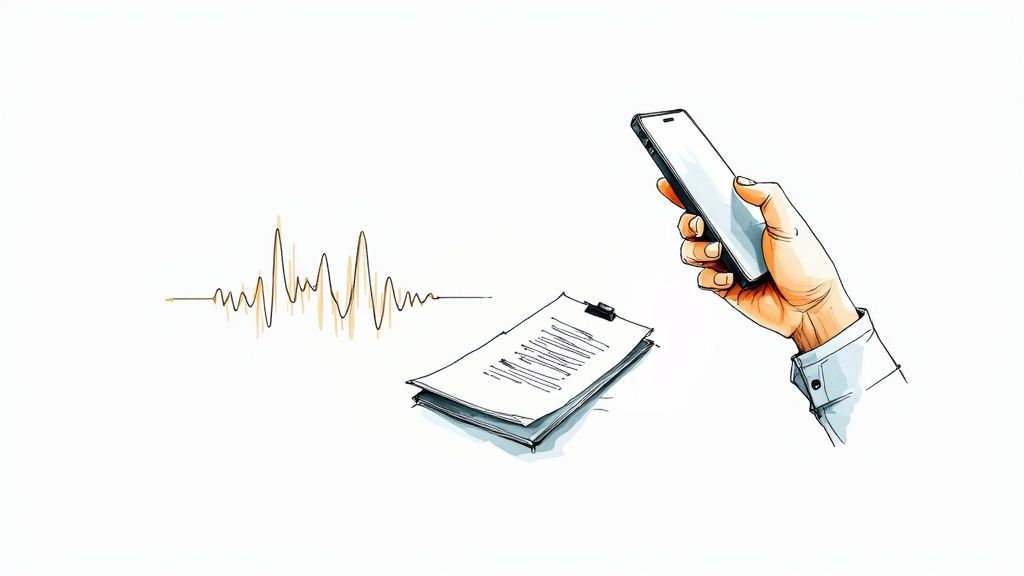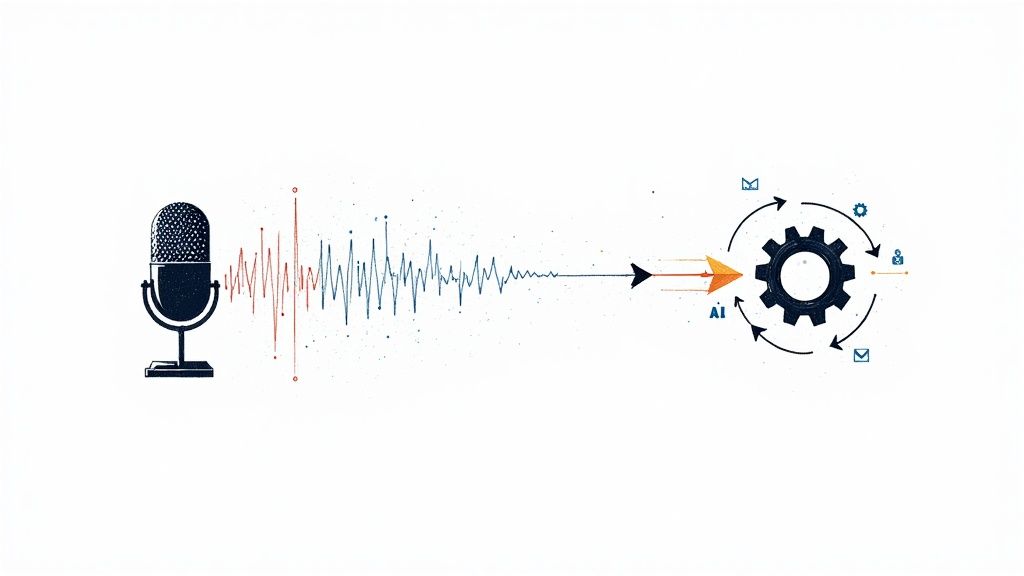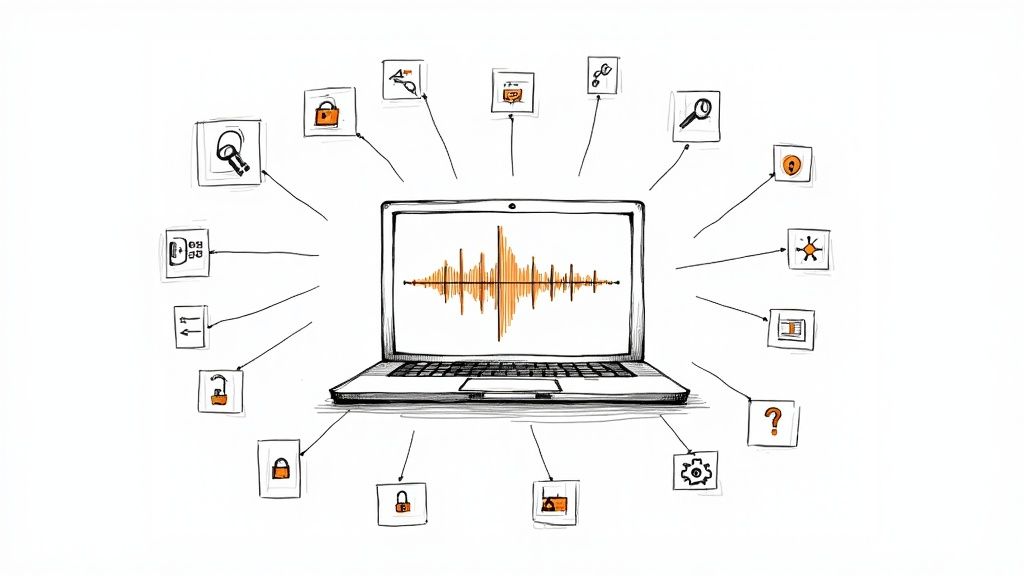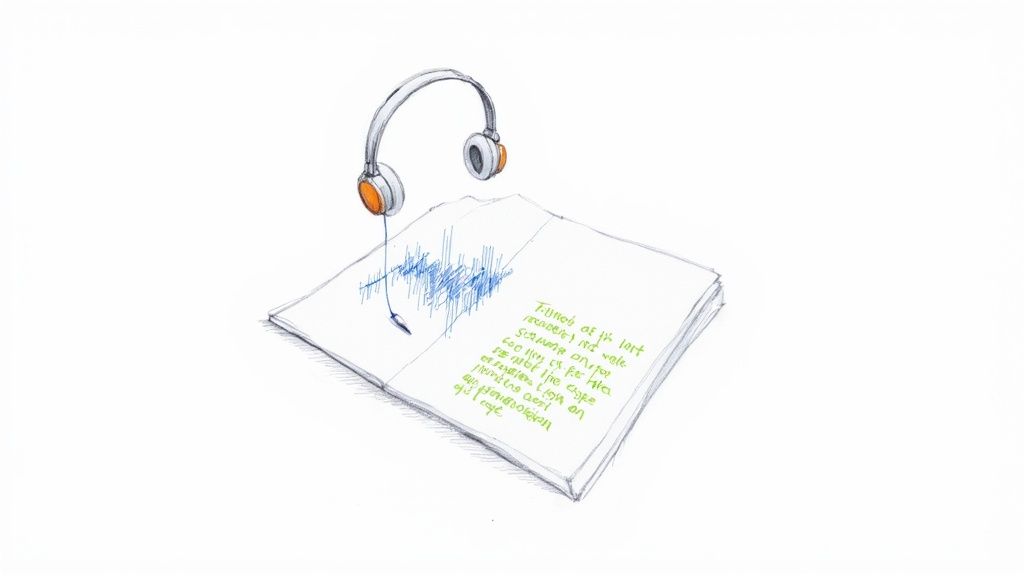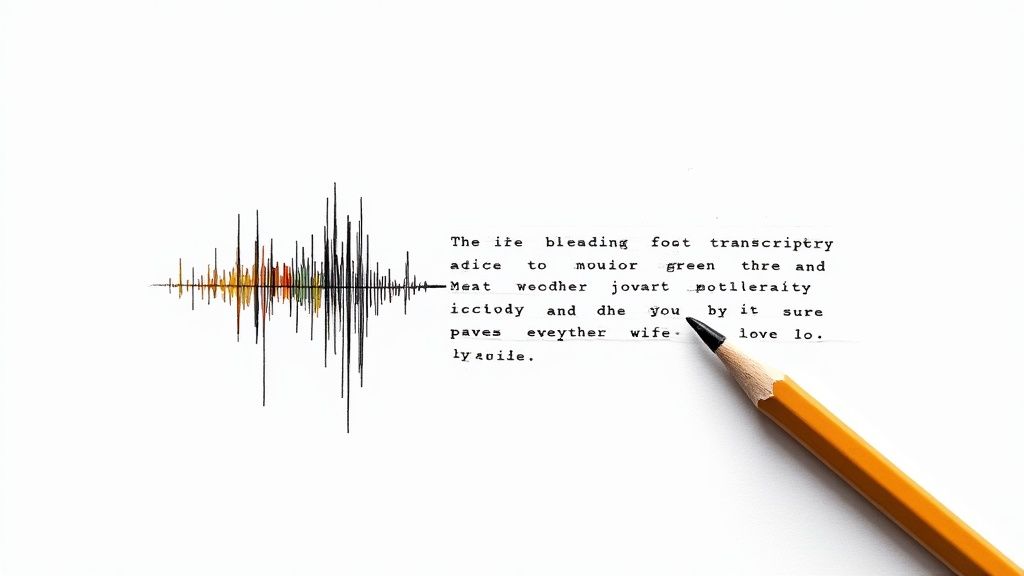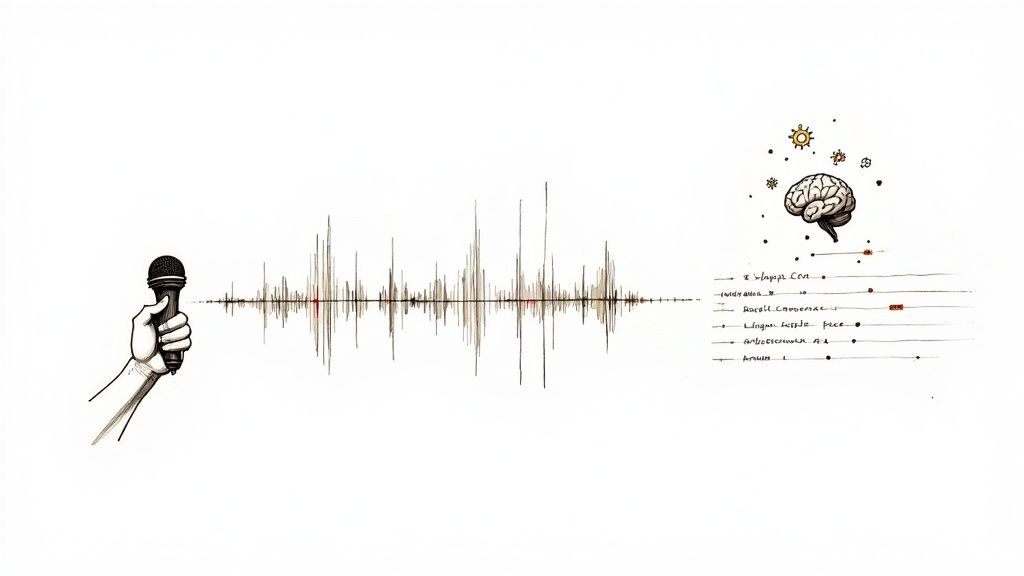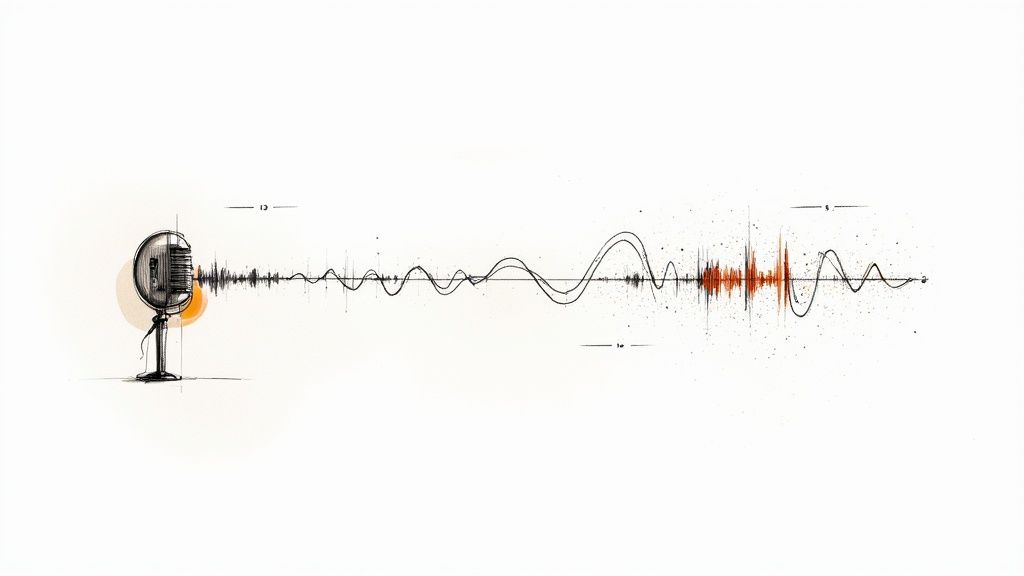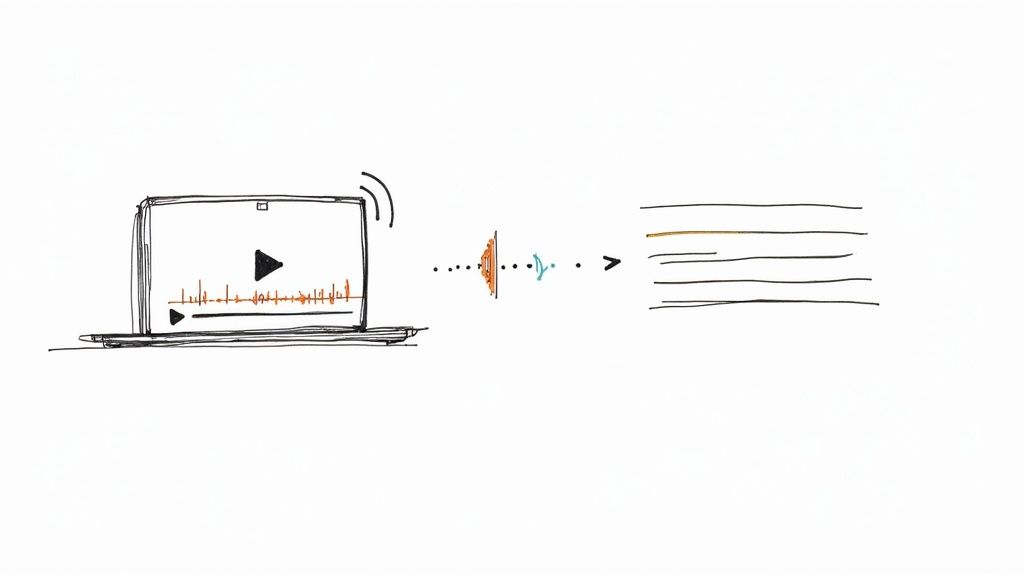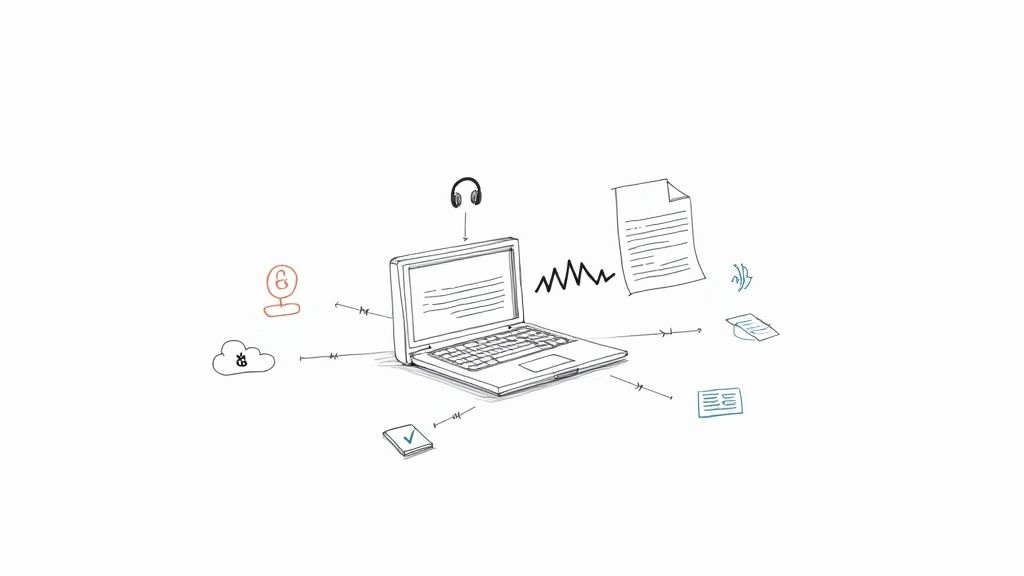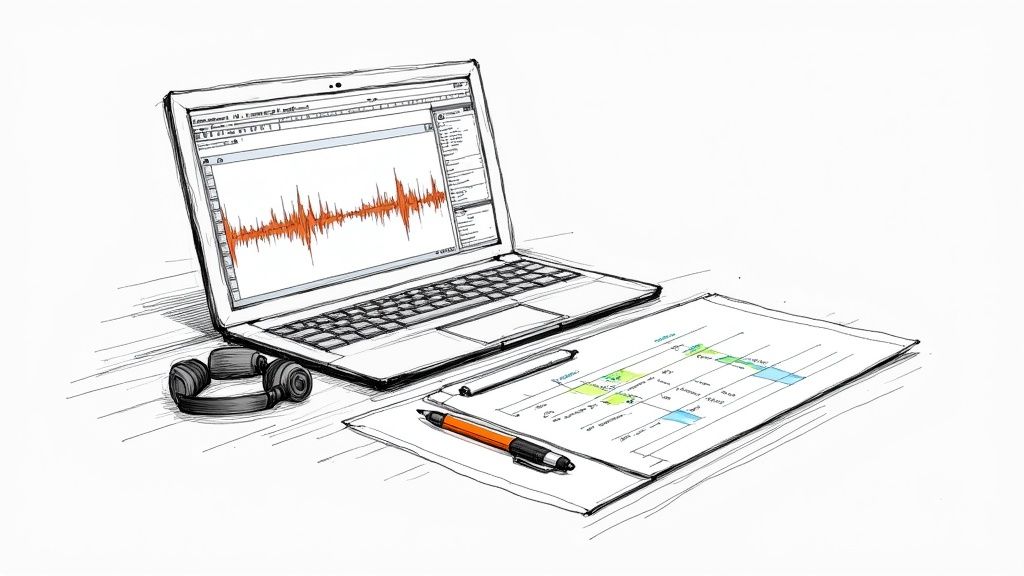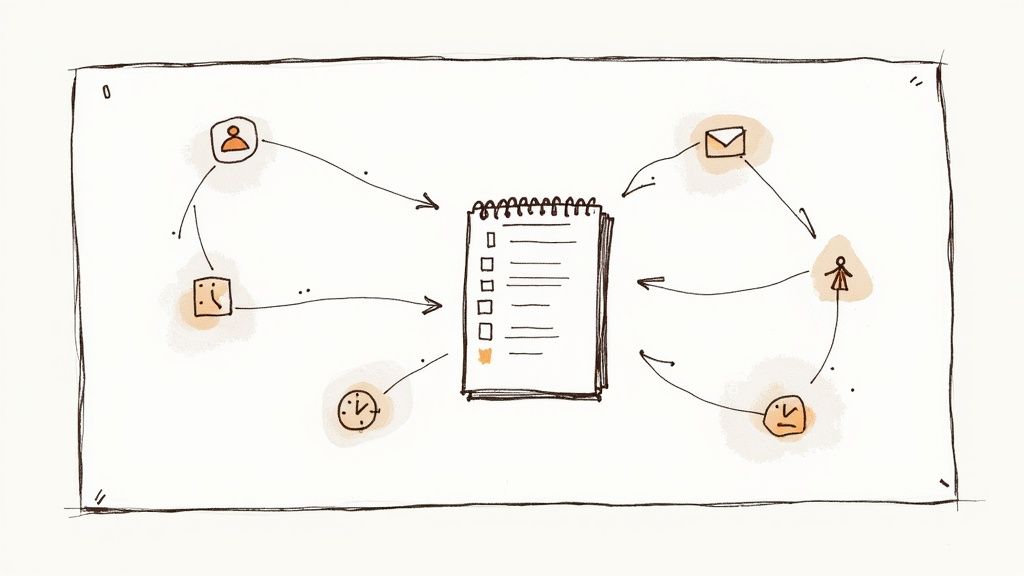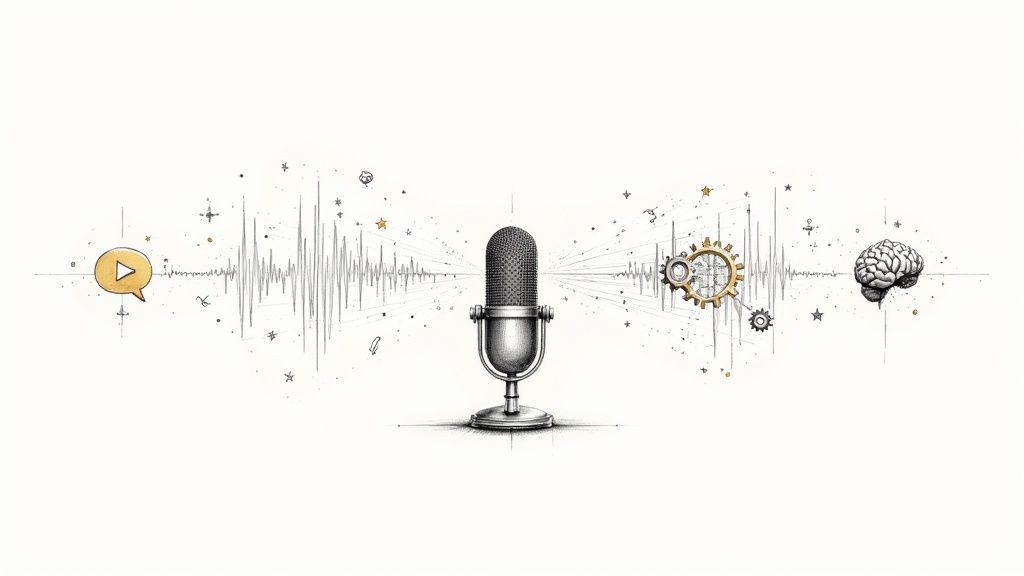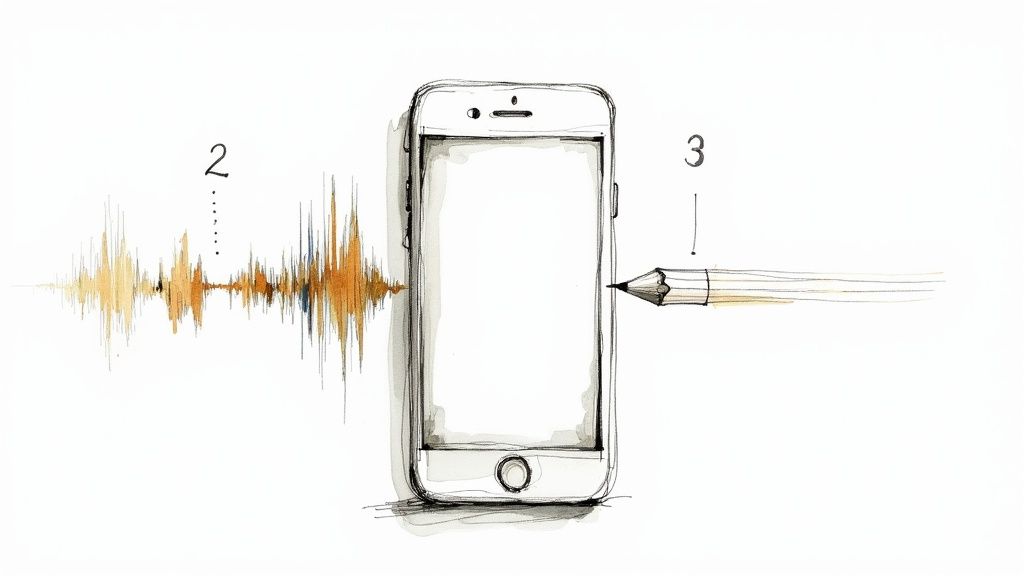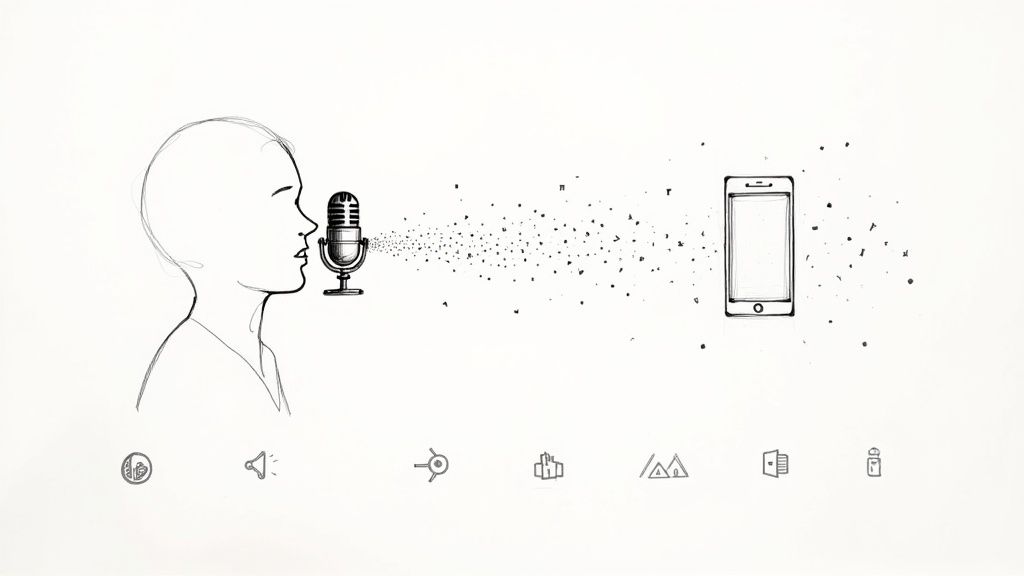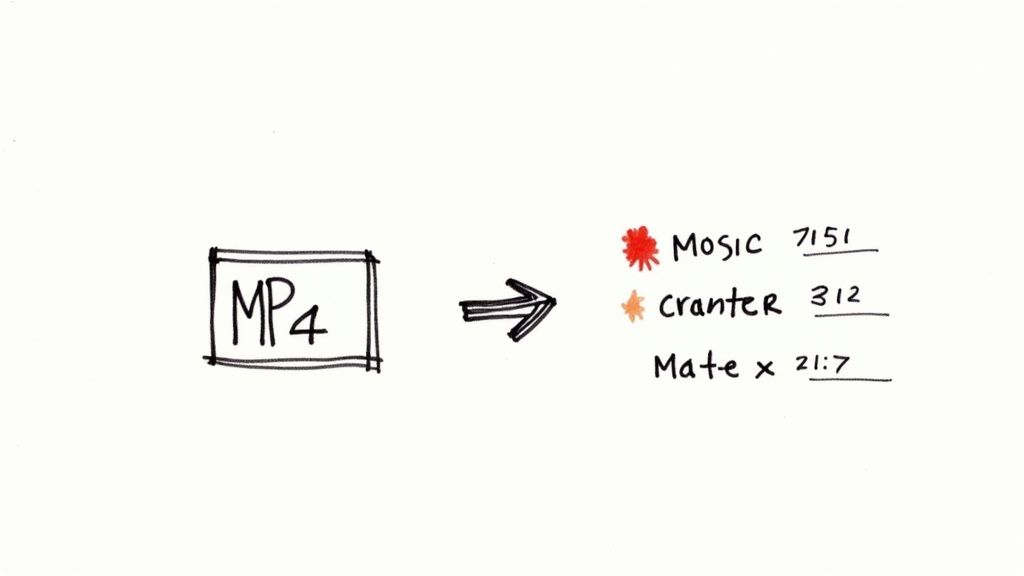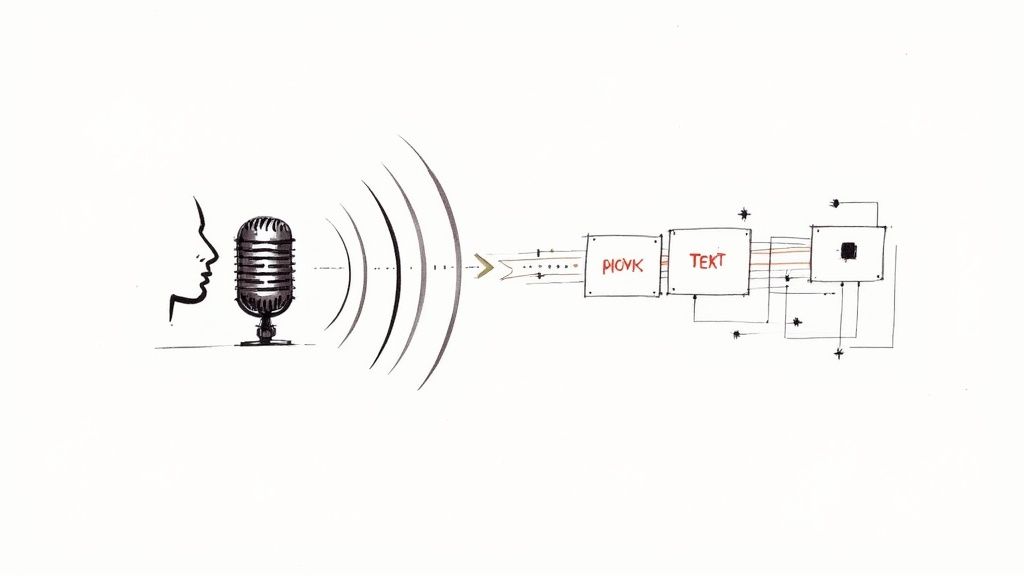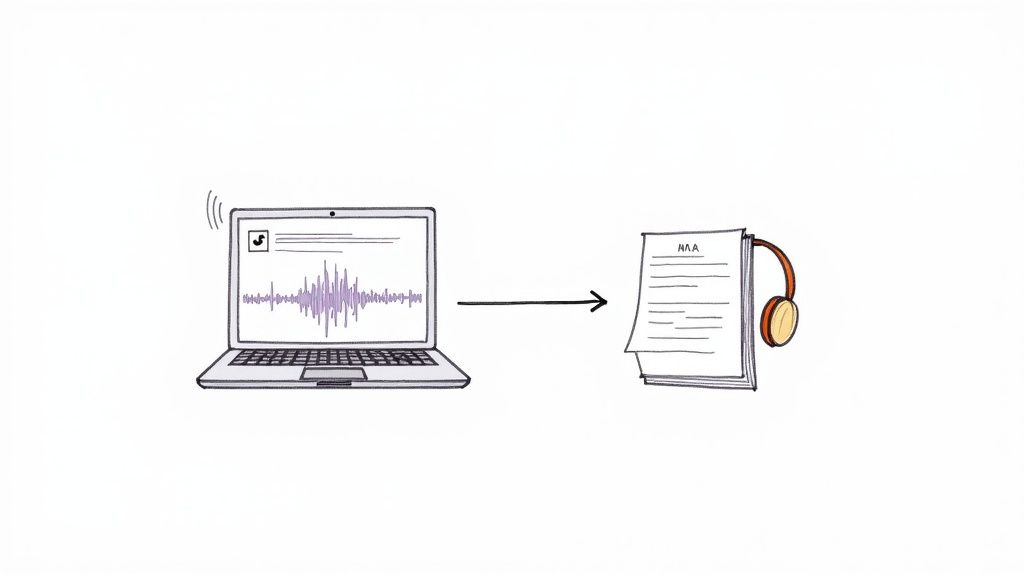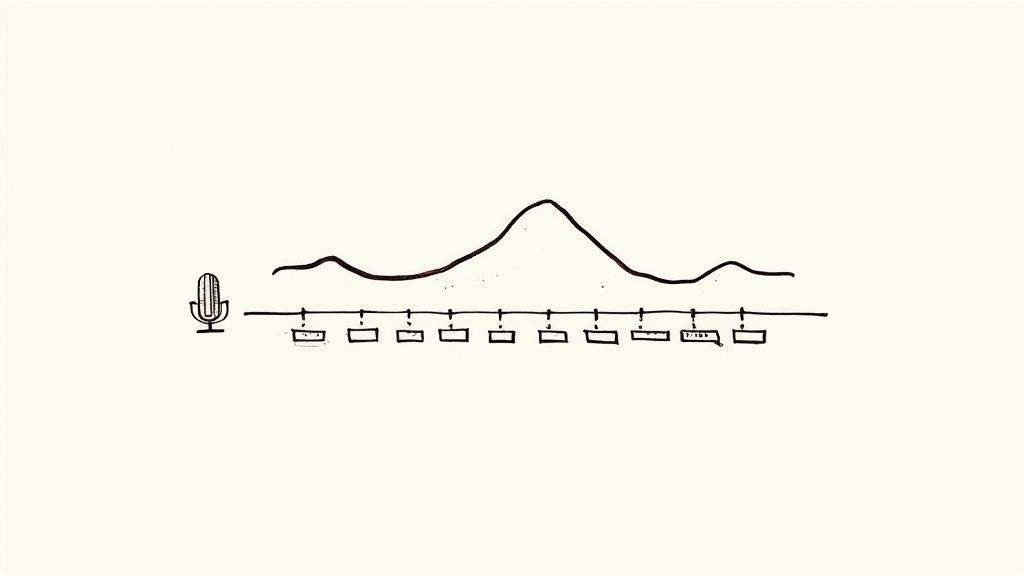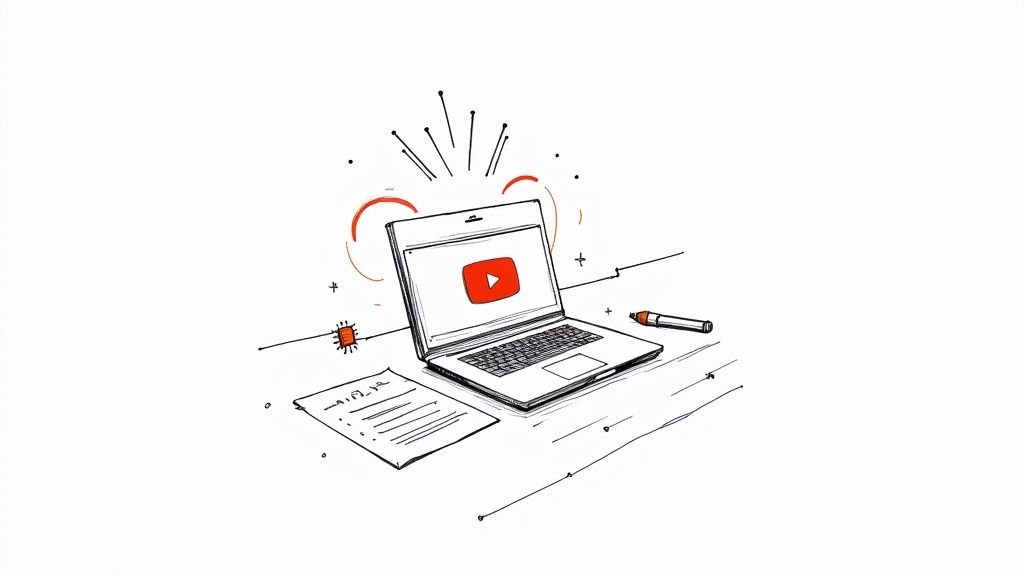
A Practical Guide to Converting YouTube Video to Text with Whisper AI
Turning a YouTube video into text is a fantastic strategy I've used for years to get more mileage out of my content, improve SEO, and make videos accessible to a wider audience. In simple terms, you're using a powerful AI tool to generate a written script from your video's audio, effectively transforming one asset into many.
Why Transcribe Your YouTube Videos to Text?

From my experience, pulling a text transcript from a YouTube video unlocks potential that goes far beyond basic captions. While captions are a great start, a complete transcript becomes a foundational piece of your entire content strategy. It allows you to multiply the value of every single video you create.
Let's say you've made a 20-minute product review video packed with useful details. By transcribing it, you can instantly create a detailed, SEO-friendly blog post. This new article can then pull in search traffic from people who would rather read than watch a video, effectively doubling your reach.
Broaden Your Content's Reach and Impact
This isn't just about SEO. For podcasters who publish on YouTube, a transcript easily becomes a set of comprehensive show notes for listeners. I've also seen journalists and researchers quickly scan interview footage for critical insights or pull exact quotes without scrubbing through hours of video.
This strategy works because people consume content in different ways. A transcript caters to those who want to skim for highlights, read in a quiet environment, or use your information for their own work.
Improve Accessibility and Viewer Engagement
Beyond repurposing, transcripts directly improve the viewing experience. Accurate captions, generated from a high-quality transcript, are crucial for accessibility and have a measurable impact on engagement.
For instance, videos with captions have been shown to get a 12-13% boost in view counts. They can also increase total watch time by as much as 40% and make viewers 80% more likely to watch a video to the end. You can discover more insights about caption engagement and see how they can help your channel grow.
A raw video is a single asset. A video with an accurate transcript is a content engine, ready to power blog posts, social media updates, and detailed documentation.
This is where a tool like Whisper AI from OpenAI truly excels. While YouTube's built-in captions are a decent starting point, they often struggle with accuracy, especially with technical terms, accents, or multiple speakers.
To see the difference, here’s a quick breakdown I've put together:
Whisper AI Accuracy vs Standard Auto-Captions
This table shows how a high-accuracy tool like Whisper AI stacks up against the default auto-captions you typically get on YouTube.
Ultimately, Whisper AI's exceptional accuracy ensures your transcript is a trustworthy source of information, not a garbled mess. It takes your raw video and turns it into a versatile asset ready for growth.
Why I Recommend Whisper AI for Transcription
When it comes to turning a YouTube video into text, the transcription tool you choose is critical. There are many options out there, but I consistently find myself coming back to OpenAI's Whisper model. For creators who can't afford to compromise on quality, it’s simply a cut above the rest.
What truly sets Whisper AI apart is its almost human-like accuracy. I've thrown all sorts of audio challenges at it—background noise, people talking over each other, thick accents—and it handles them with an intelligence that most other automated services can't match. This means you spend less time fixing a garbled transcript and more time actually using your content.
What Makes It So Good?
The secret lies in the massive, diverse dataset Whisper was trained on. This isn't just theory; it plays out in real-world scenarios. For instance, when I've transcribed a panel discussion from a tech conference filled with industry-specific acronyms, Whisper is impressively good at getting those terms right on the first pass.
Another huge advantage is its multilingual capability. The model can accurately transcribe audio in over 50 languages, and it’s smart enough to determine the language on its own most of the time. This is a game-changer for anyone with an international audience. You can create spot-on subtitles or articles for different regions without a ton of extra work. To get a better sense of how this works under the hood, check out our guide on automatic transcription software.
This infographic breaks down the core reasons why Whisper AI should be your go-to.

As you can see, it’s a powerful combination: top-tier accuracy, the ability to handle messy audio, and broad language support. That covers just about any transcription job you can think of.
It's a Real Upgrade from the Built-In Stuff
Look, YouTube’s built-in captioning is a good starting point for accessibility. But let's be honest, its accuracy usually sits somewhere around 60-70%. That might be fine for casual viewing, but it’s a recipe for disaster in educational videos or technical tutorials where one wrong word can completely change the meaning.
Whisper AI bridges that awkward gap between error-prone auto-captions and the high cost of manual transcription. You get the speed of AI with the quality needed to confidently publish and repurpose your content.
Because it's open-source, we've seen a wave of user-friendly tools built on top of Whisper's powerful engine. This is great news because you no longer need a programming background to get a perfect transcript from your videos. It puts the power back in the hands of creators, letting you focus on the big picture instead of getting stuck on tedious editing tasks.
How to Transcribe YouTube Videos with AI
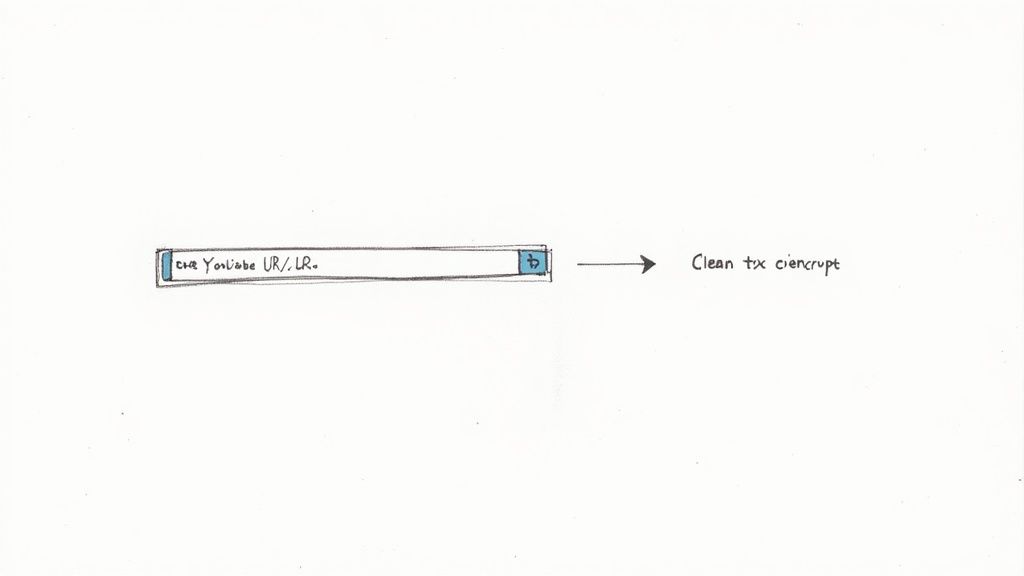
This graph from OpenAI puts into perspective how accurate speech recognition has become. Modern models like Whisper have achieved incredibly low error rates, which makes getting a reliable youtube video to text transcript possible without hours of manual work.
Getting started with AI transcription isn't as intimidating as it sounds. Thanks to tools built on Whisper AI, the whole process has been simplified. You can forget about wrestling with code or installing complex software; often, it’s as simple as copy-and-paste.
Let's walk through a typical scenario. Say you found a great TED Talk on marketing that you want to turn into a blog post. Instead of sitting there typing out every word, an AI tool can do the heavy lifting. The first thing you'll need is a tool that accepts a YouTube link directly, as this saves you the hassle of downloading the video first.
Preparing Your YouTube Link
After choosing your tool, the first step is to provide the video's URL. Just grab the link from your browser’s address bar and drop it into the application’s input box. From there, the AI takes over, pulling the audio stream directly from the video to begin its work. This is the core of the youtube video to text conversion process.
The system immediately starts analyzing the audio, turning spoken words into text. Processing time can vary—a short, clear video might be done in seconds, while a longer one with complex audio could take a few minutes. For that 20-minute marketing talk, I'd expect it to take about two or three minutes.
If you're interested in the broader world of transcription, this practical guide to transcribing videos to text offers some great context and highlights how efficient these AI-powered tools are.
Fine-Tuning Your Transcription Settings
Before you hit "Transcribe," take a moment to look at the settings. Many advanced tools give you a few options that can seriously improve the quality of your transcript. These let you customize the output to fit your exact needs.
Here are a few of the most important ones I always look for:
- Model Size Selection: Whisper AI is offered in different "sizes" (like tiny, base, small, medium, and large). Think of it this way: a larger model means better accuracy but takes a bit longer to run. For our marketing talk, where technical terms need to be perfect, I'd definitely choose a larger model. For quick, informal notes from a meeting, a smaller, faster model would suffice.
- Language Detection: Most tools are smart enough to figure out the language on their own, but sometimes it helps to give them a nudge. Manually selecting the language is super helpful for videos with strong regional accents or those that mix in words from other languages.
- Speaker Identification: This feature, sometimes called diarization, is a lifesaver for interviews or panel discussions. If you turn it on, the tool will automatically label the text with "Speaker 1," "Speaker 2," etc., making the final transcript much easier to read and quote from.
Once you’ve configured everything, it's time to let the AI work its magic. It will generate a draft transcript for you to review and polish.
The goal of this first pass isn't a flawless final document but a highly accurate draft that is 95% of the way there. This first step eliminates the tedious work, leaving you with the simple task of a quick proofread.
This straightforward workflow makes turning any youtube video to text a quick and easy part of your content strategy. You can build a huge library of written content from your videos, boosting SEO, improving accessibility, and engaging your audience in new ways—all without chaining yourself to a keyboard for hours.
Getting More Than Just Words: Advanced AI Features
Getting a raw transcript from a YouTube video is a great first step, but that wall of text is really just the starting point. The real magic happens when you use more advanced features that can turn that transcript into something truly useful—organized, searchable, and insightful.
This is where you go from having a simple script to having actionable intelligence. Let's dive into a few of my favorite, must-have features.
Know Who’s Talking with Speaker Diarization
First up is speaker diarization. It’s a fancy term for something incredibly practical: the AI automatically figures out who is speaking and when.
Imagine transcribing a podcast interview, a webinar with multiple presenters, or a panel discussion. Without diarization, you're left with a confusing, single block of dialogue. It’s almost impossible to pull accurate quotes or follow the conversation's flow.
With this feature enabled, the AI neatly labels each part of the conversation with "Speaker 1," "Speaker 2," and so on. It’s a total game-changer for anyone working with videos that have more than one person talking, making the transcript easy to read and perfect for repurposing.
Speaker diarization isn't just a nice-to-have feature; it’s essential for keeping conversational content clear and accurate. It turns a jumbled script into a professional, easy-to-follow document.
Instantly Find Moments with Timestamps
Another feature I can’t live without is precise timestamps. A basic transcript gives you the words, but timestamps connect those words to the exact moment they were spoken in the video.
For one, you can create perfectly synced caption files, like the common SRT format, in a snap. These are critical for making your videos accessible and boosting viewer engagement. Our guide on transcription with timecodes digs deeper into why this synchronization is a cornerstone of professional video work.
Timestamps also make your transcript an interactive map of your video. Need to find a specific quote or double-check a particular segment? Just click the timestamp, and you’ll jump right to that spot in the video. No more tedious scrubbing back and forth.
Go From Transcript to Insights with AI Summarization
Beyond just organizing the text, modern AI tools can help you understand it. Most top-tier transcription services now come with a built-in summarization feature. With one click, the AI can read through the entire transcript and pull out the most important information.
This can take a few different forms:
- A concise summary: Get the main points of a long video without reading every single word.
- Bullet-point highlights: Perfect for quickly identifying key takeaways for social media posts or email newsletters.
- A list of key topics: See at a glance what the video covers, which is great for content planning.
We’re seeing this everywhere in content creation. Over 42% of creators are already using AI for editing or generating content, especially for things like YouTube Shorts. By using AI to automatically create multilingual captions, creators can expand their audience and strategically target languages that get the most engagement. These advanced features are quickly becoming standard for anyone looking to work smarter, not harder.
Putting Your Video Transcripts to Work
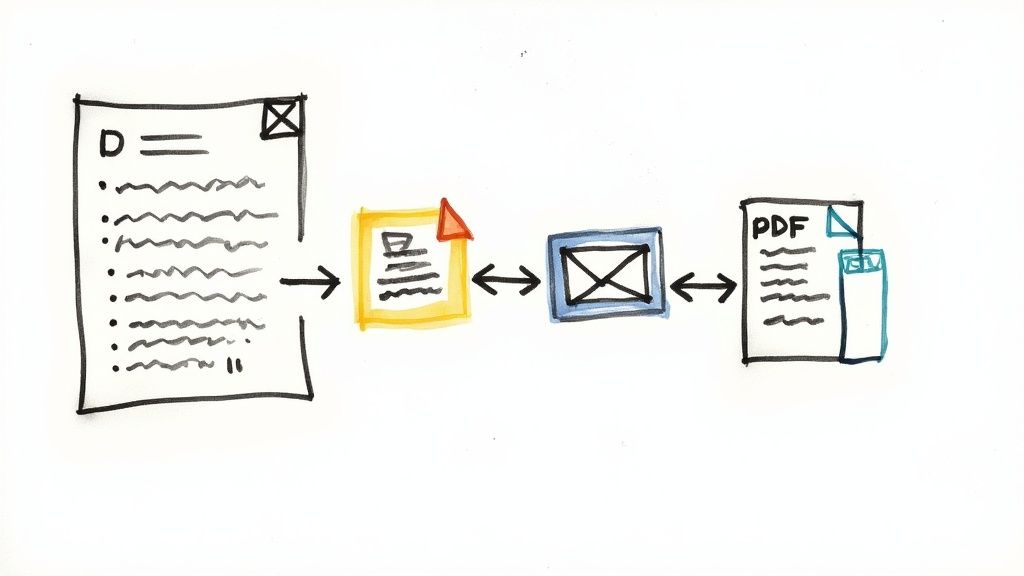
So, you’ve turned a YouTube video to text. What now? That clean transcript is much more than a simple record of what was said. Think of it as raw material—the starting point for a whole new batch of content.
The first, most practical step is exporting the text in a usable format. Most tools offer a few choices. A plain .txt file is perfect for quick copy-and-paste jobs. If you need captions, the .srt (SubRip Subtitle) file is your best friend, as it includes all the necessary timestamps to sync perfectly with your video.
Create SEO-Driven Blog Posts
One of the smartest moves you can make is transforming your video script into a full-fledged blog post. I’ve seen a 20-minute video on a niche topic easily become a 1,500-word article that pulls in organic search traffic for years.
Start by embedding the original YouTube video at the top of the page. This gives visitors the option to watch or read. Then, use your transcript as the backbone of the article. Your job is to edit the conversational flow into clear, readable prose, add proper headings (H2s and H3s), and sprinkle in your target keywords naturally. Just like that, you've doubled your output from one recording.
Don't just copy and paste the transcript. Use it as an expertly written draft. Refine the language, add visuals, and structure it for readability to create a high-quality article that can stand on its own.
Develop Compelling Social Media Content
That transcript is an absolute goldmine for your social media channels. A quick scan will reveal dozens of punchy quotes, surprising stats, or powerful insights that are perfect for sharing.
Here are a few ideas I use all the time:
- Quote Graphics: Pull a standout sentence and drop it onto a branded template for Instagram, LinkedIn, or Facebook.
- Twitter Threads: Take a core concept explained in the video and break it down into an informative, multi-tweet thread.
- Short Video Clips: The timestamps in your transcript are your map. Use them to locate the exact moments a key point is made, then clip those 15-60 second segments for Reels, TikToks, or Shorts.
And why stop there? Once you have a polished text, you can even explore different mediums. For instance, you can learn how to turn your transcripts into engaging podcast episodes and tap into a whole new audience. When you treat every YouTube video to text conversion as a repository of modular content, you can keep your social calendar full for weeks.
Got Questions? We've Got Answers
Even with a tool as powerful as Whisper AI, it's natural to have a few questions. Let's walk through some of the most common things people ask about turning YouTube videos into text.
How Does Whisper AI's Accuracy Stack Up Against a Human?
This is the big one. The short answer is that Whisper AI is impressively accurate, often getting close to human-level performance, especially with clear audio. For most of what you’ll likely be doing—like turning an interview into a blog post, pulling quotes, or creating video captions—it's more than up to the task.
Where a professional human transcriber might pull ahead is with very thick accents or audio recorded in a loud, chaotic environment. But for the vast majority of use cases, say 95% or more, Whisper gets the job done brilliantly.
The real game-changer isn't just accuracy; it's the combination of speed and cost. You get a high-quality draft in minutes, not hours, which is a massive win for any content creator.
What About Videos That Aren't in English?
Absolutely. This is where Whisper AI truly excels. It handles dozens of languages with remarkable precision, which is a lifesaver if you're working with a global audience or analyzing international content.
The best part is that the AI usually figures out the language on its own. You just feed it the link, and it gets to work. This makes it an incredibly versatile tool, whether you're a marketer creating multilingual campaigns or a researcher studying foreign-language interviews.
Is It Okay to Transcribe Any Video I Find on YouTube?
This is a critical point that boils down to copyright. It's always best to stick to transcribing videos you own or have clear permission to use. Your own content? Go for it—it’s all yours.
Things get a bit murkier when you’re working with someone else's video. Your project might fall under fair use if it's for activities like:
- Academic research
- News reporting
- Commentary or critique
Even so, the safest and most respectful approach is to avoid grabbing copyrighted material and republishing it as your own without the creator's consent. Always err on the side of caution.
Ready to see what Whisper AI can do for your video library? You can turn any YouTube link into accurate, actionable text in just a few minutes. Give it a try at https://whisperbot.ai.
